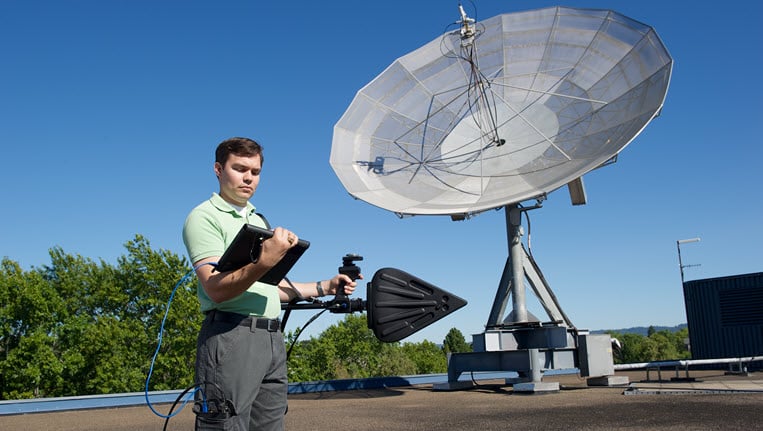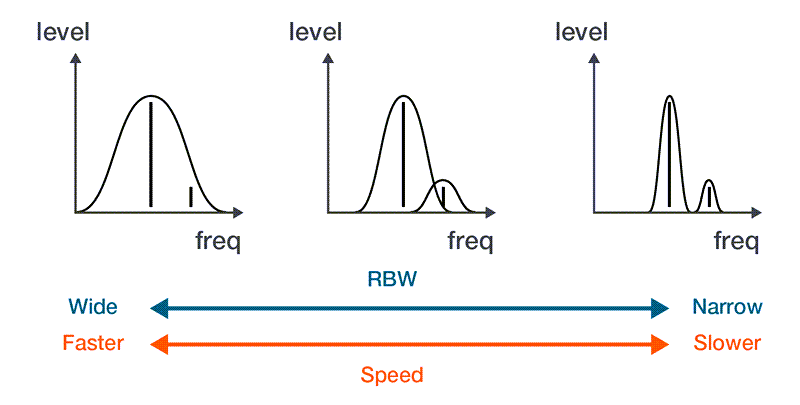

One term we see quite often when breaking down spectrum analyzers is probability of intercept (POI). So, what is the definition of probability of intercept and why does it matter?
When we see “probability of intercept” we should know that this term is almost always a contraction of the phrase “minimum event duration for 100% probability of intercept”. POI is the amount of time equal to “the minimum duration of a signal to guarantee the instrument will be able to visualize the signal, untriggered, at full amplitude, even if it only occurs once”. With regards to spectrum analyzers, it refers to the time that the signal needs to be present so that the spectrum analyzer is guaranteed to capture it. POI is typically measured in micro- or nanoseconds.
While the specification POI is a length of time, you will also hear engineers discuss “low” or “high” probability of intercept. Instead of referring to the length of time for a 100% chance of intercept, these phrases refer to the probability of intercept for some arbitrary or unspecified length of time. Hearing “low POI” means “low probability”; the instrument requires a longer signal duration for 100% probability of intercept. “High POI” means a higher probability, therefore a shorter signal duration to give 100% POI and ultimately a smaller number in the spectrum analyzer datasheet.
Making Sense of POI
With traditional spectrum analyzers, the instrument sweeps in frequency from low to high. If you’re looking for a signal that’s not there very often, the fact that the instrument is sweeping is a problem since the offending signal could be on or off as the analyzer sweeps past it, and that signal may never be captured. The problem is personified by the probability of intercept or POI specification.
As you might imagine, given their sweeping architecture, swept-tuned spectrum analyzers have a low probability of intercept, meaning that the interfering signal may have to be on for a long period of time for a sweeping analyzer to fully characterize the signal. Real-Time Spectrum Analyzers (RTSAs) are able to continuously measure the spectrum for any span of frequencies up to their maximum real-time span. This means that their POI is very good, allowing the guaranteed capture of very short duration signals. What’s more, operators are able to get the information much faster and even record and store live spectrum data for later analysis.
The sweeping nature of traditional spectrum analyzers limits the POI when analyzing short duration signals. This problem is particularly acute when we need to make “Over the Air” (OTA) measurements. When monitoring for interference the spectrum analyzer must mimic the operation of the victim receiver. Part of this involves adjusting the resolution bandwidth (RBW) filter of the spectrum analyzer. By default, most spectrum analyzers will set the RBW filter as a ratio of the span setting.
When analyzing interference problems, the RBW control is very important. The RBW filter helps us discriminate signals in the spectrum so that we can determine individual sources of RF energy within the span we are monitoring. The image below illustrates why the RBW setting is so important. If RBW is too wide, as it is on the left side, the spectrum analyzer is going to miss smaller signals that might be close to a larger signal. With a very narrow RBW, the spectrum analyzer can easily discriminate between the two signals that are close together. However, a narrow RBW will slow down the spectrum analyzer, meaning that a longer signal duration is required in order to guarantee probability of intercept.

Figure 1. Looking at two signals of different power levels, a wide RBW means a faster measurement, but small signals can be obscured near large signals or under the higher noise floor.
Why It Matters
Balancing the trade-offs between POI, RBW and other settings is required for capturing intermittent signals in a reasonable time. Some spectrum analyzers limit your RBW options by restricting the measurement span: RBW ratio, making it difficult to find settings that give you a clear signal in a reasonable time. When evaluating a spectrum analyzer, be sure it gives measurement flexibility you will need for your application.
For spectrum managers and anyone charged with tracking down sources of interference, this means that traditional interference hunting tools – primarily the swept tuned spectrum analyzer – are no longer adequate because of their poor probability of intercept and other shortcomings.

Figure 2: Finding spurious signals while hunting interference is one application that requires a small POI spec and perhaps a narrow RBW.
With the introduction of our USB-based real-time spectrum analyzers, interference hunters now have the right tool for identifying short-duration signals in a noisy, crowded spectrum. With a high probability of intercept, RTSAs can see signals missed by the low-performance spectrum analyzers typically used for interference hunting. When coupled with SignalVu-PC software, our USB-based spectrum analyzers offer such powerful features as record and playback, mask search and integrated direction finding and mapping.
Something important to note before we end, RTSAs that can seamlessly record RF signals over time, sometimes called Signal Analyzers, are capable of measuring signals much shorter than their rated probability of intercept. For example, a spectrum analyzer with a POI of 15 microseconds might characterize a signal lasting just 10s of nanoseconds perfectly well. While in continuous, untriggered operation, signals shorter than the POI specification are less likely to be visualized at full amplitude, with the probability of capturing them decreasing as the signal duration decreases below the POI.
To learn more about spectrum analyzers and the specifications that define them, download our guide to the fundamentals of real-time spectrum analysis.

